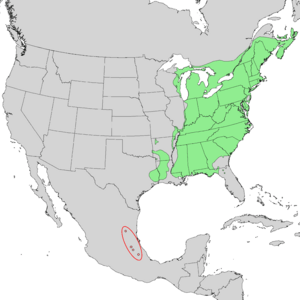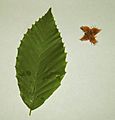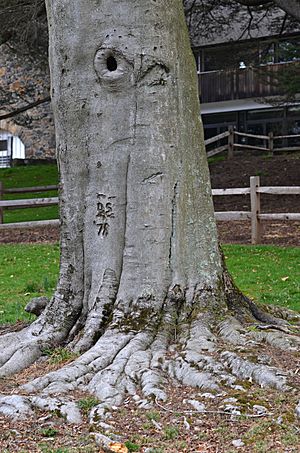American beech facts for kids
Quick facts for kids American beech |
|
|---|---|
 |
|
| Conservation status | |
| Scientific classification | |
| Genus: |
Fagus
|
| Species: |
grandifolia
|
 |
|
| Natural range of Fagus grandifolia | |
The Fagus grandifolia, also known as the American beech or North American beech, is a type of beech tree. It grows naturally in the eastern parts of the United States and the very southeastern areas of Canada.
The name Fagus comes from a Latin word meaning "beech". The second part of its scientific name, grandifolia, means "large leaf". This is because grandis means "large" and folium means "leaf".
Contents
Where American Beeches Grow
The American beech tree is found across eastern North America. You can find it from Nova Scotia in Canada, west to southern Ontario. In the United States, it grows west to Wisconsin and south to eastern Texas and northern Florida.
Some trees in the southern part of this area are sometimes called a different type, F. grandifolia var. caroliniana. However, many experts do not see it as a truly separate kind. The Mexican beech (Fagus grandifolia var. mexicana) is a close relative. It grows in the mountains of central Mexico. Some scientists think it is a type of American beech, while others see it as its own species.
The American beech is the only Fagus species found in North America. Scientists believe it once grew all the way to the Pacific coast. This was before the last ice age.
What American Beeches Look Like
Size and Bark
The American beech is a deciduous tree. This means it loses its leaves in the fall. It can grow to be about 20 to 35 meters (65 to 115 feet) tall. It has smooth, silver-gray bark.
Leaves and Buds
Its leaves are dark green. They are simple and have small teeth along their edges. Each tooth is at the end of a vein. The leaves are usually 6 to 12 centimeters (2.4 to 4.7 inches) long. They have a short stem called a petiole.
The winter twigs are special and easy to spot. They are long and thin, about 15 to 20 millimeters (0.6 to 0.8 inches) long. The buds look like small cigars. This unique shape helps you identify beech trees.
Flowers and Fruit
The tree is monoecious. This means it has both male and female flowers on the same tree. The fruit is a small, sharply-shaped nut. These nuts grow in pairs inside a soft, spiny, four-part husk.
How They Grow
American beeches can reproduce in two ways. One way is through seeds that grow into new trees. The other way is through root sprouts. This is when new trees grow directly from the roots of an existing tree.
Where They Live in the Forest
The American beech can grow well in shady areas. It is often found in forests that are in the final stage of succession. This means the forest has been changing over time. Few other trees in its natural area can handle as much shade as the American beech.
It is sometimes found alone, but usually grows with other trees. These include sugar maple, yellow birch, and eastern hemlock. They often grow on moist, well-drained hillsides and rich lowlands. In warmer southern areas, it often grows with southern magnolia.
Growing Conditions
American beeches are known for growing slowly. Sometimes they only grow about 4 meters (13 feet) in 20 years. But if they have rich soil and plenty of water, they can grow much faster. They like places that are well-watered but also drain well.
These trees do not do well with city pollution, salt, or packed-down soil. They also create a lot of shade. They need a lot of water compared to oak trees. They have a thick, shallow root system.
Even though they grow across much of eastern North America, old American beech trees are rare in low areas. This is because early settlers learned that these trees meant the land was good for farming. So, they often cleared these areas.
Gallery
-
Bark with lichen
-
Seedlings of beech and maple in a beech–maple forest, Johnson City, TN
Tree Health and Dangers
Beech Bark Disease
Beech bark disease is a big problem for beech trees in the Northeastern United States. This disease happens when tiny insects called beech scale insects (Cryptococcus fagisuga) attack the bark. They create small wounds. Then, one of two types of fungi from the genus Nectria infects these wounds. This causes a sore, or canker, to grow, and eventually the tree dies.
Beech Blight Aphids
Beech blight aphids gather on the branches of the tree. But they usually do not cause serious harm to healthy trees. Below these groups of aphids, you might see black, sooty mold. This mold grows because of a fungus called Scorias spongiosa. It feeds on the sticky liquid, called honeydew, that the aphids release. This mold also does not harm the trees.
Beech Leaf Disease
Beech leaf disease was first found in Ohio in 2012. Scientists think tiny worms called nematodes cause it. This disease has spread to several other states and Canada. It could potentially kill millions of trees in North America. It might even threaten beech trees in Europe.
Other Dangers
Even though beeches need a lot of water, they can easily die from too much flooding. Their thin bark can also be damaged by animals, fire, and human actions. Late spring frosts can also hurt the tree a lot. Older beech trees often get rotten trunks and hollow spaces. These spaces are then used by wildlife for homes.
Uses of the American Beech
Wood Uses
American beech wood is important in forestry. The wood is hard and tough to cut or split. It is not extremely heavy, but it can rot fairly easily. It is used for many things. It is especially good for bentwood furniture because beech wood can be easily bent when it is steamed. It also makes good firewood that burns for a long time.
Carving on Bark
Like the bark of the European beech, the American beech bark is smooth and even. This makes it a popular place for people to carve names, dates, hearts, or other symbols. One famous beech tree in Louisville, Kentucky, had a carving from 1775. This tree fell in a storm in 1916. It was thought to be about 325 years old. Its trunk is now on display at The Filson Historical Society.
Planting as an Ornamental Tree
Sometimes, American beech trees are planted to make gardens or parks look nice. But even where they grow naturally, they are planted less often than the European beech. The European beech grows faster and can handle more pollution. It is also easier to grow new trees from it.
Nuts and Wildlife Food
American beech trees do not produce many nuts until they are about 40 years old. They produce large amounts of nuts when they are around 60 years old. The oldest known tree lived for 246 years. The fruit is a triangle-shaped shell with 2 to 3 nuts inside. However, many of these nuts do not fully develop, especially on trees that grow alone.
Raw beech nuts can be eaten by wildlife and humans. They can also be cooked. But they are too small to be sold for a lot of money. The large amount of nuts (called "mast") from American beech trees provides food for many animals. These include wild turkeys, raccoons, foxes, deer, rabbits, squirrels, and bears. Deer sometimes eat beech leaves, but it is not their favorite food. Beech nuts were a main food source for the passenger pigeon, which is now extinct. Cutting down beech and oak forests was a big reason why this bird disappeared.
See also
 In Spanish: Haya americana para niños
In Spanish: Haya americana para niños














